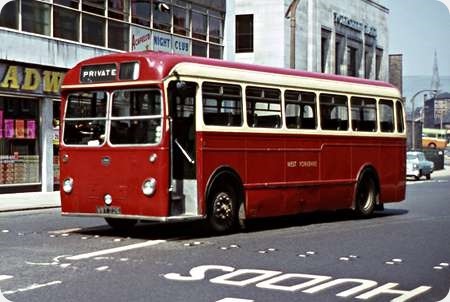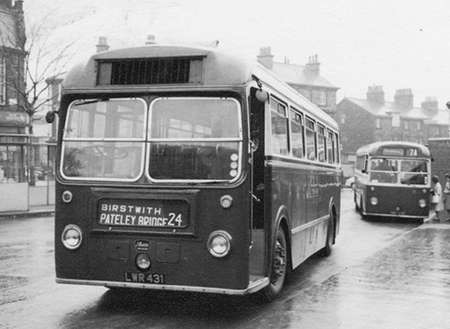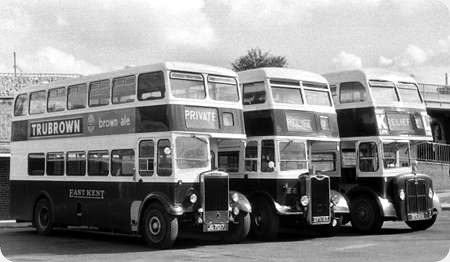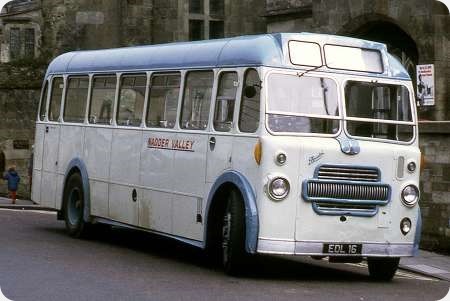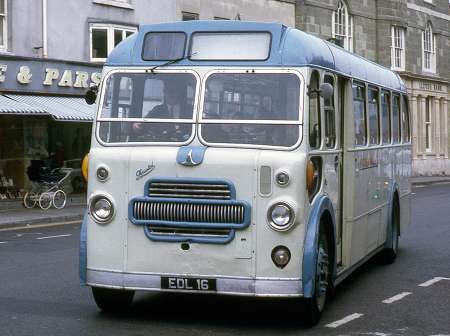West Yorkshire – Bristol LS5G – MWY 226 – EUG 15
West Yorkshire Road Car Co
1954
Bristol LS5G
ECW DP41F
Quite what this Harrogate based West Yorkshire LS5G was doing in Waterhouse Street, Halifax, in the summer of 1965 I am unsure, but it seems to be a curious choice of vehicle if it was on private hire duty. No doubt our Halifax experts will come up with a suggestion. MWY 226 was delivered to West Yorkshire’s Harrogate depot in July 1954 as a dual purpose vehicle and it then carried the fleet number EUG 15 (Express Underfloor Gardner). In March 1959 its role was downgraded to that of a bus with the new fleet number SUG 15 (Single deck Underfloor Gardner) in which guise, a trifle battered, it is seen here. It was still based at Harrogate when finally withdrawn in October 1968 thereafter passing into the hands of dealers.
Photograph and Copy contributed by Roger Cox
18/10/19 – 05:24
Although West Yorkshire’s LS5Gs were renumbered from EUG to SUG, and repainted in the livery shown, they retained their dual purpose seats until some time in the sixties, so would have been suitable for a private hire job, especially if it was a summer Saturday.
Many years ago Crosville charged a lower rate for private hires if a dual purpose vehicle was used rather than a coach. Perhaps West Yorkshire had a similar scheme?
Don McKeown
18/10/19 – 05:25
West Yorkshire never bought any new LS pure service buses, but they did eventually re-seat many of the dual-purpose vehicles with bus seats. Sixty-eight were received as LS5G’s with ECW DP41F bodies and they came in five batches from 1953 to 1958. All of them had no rear indicators and the front indicators were always of two side-by-side windows. Each of the five batches had slight body variations and this along with West Yorkshire’s "normal" policy of declassifying/ re-seating/ livery changes gave a visually mixed and varied picture.
Stuart Emmett
20/10/19 – 06:39
I think it made economic sense to buy saloons in DP form then as they became older to reseat and down grade them to buses. Although I would love to know where all the bus seats came from to facilitate this, presumably from older, withdrawn stock.
A common nick name for the "SUG"s was "SLUGS" presumably due to the limited power produced by their five pot Gardners.
Mr Anon
21/10/19 – 06:07
ECW did some of the bus seat conversions Mr. Anon = a long way to/back from Lowestoft.
Stuart Emmett
28/10/19 – 06:57
Some fascinating memories, and how good it is to see the stalwarts getting some recognition. They were put to work on anything going. I used to work as a junior traffic clerk, latterly at Low Harrogate in the mid-60s, which was where tours and private hires were dealt with. There was no discount for using DPs instead of coaches. All quotes for hires were charged at the same mileage rate and the whole fleet for the allocation to Harrogate was particularly smart because it was Head Office. You should have seen the things which were hired out when the film "Sound of Music" was showing in Leeds! We were desperately short of vehicles and reckoned we could have hired out a tow truck. Private hire and tours were based in Montpelier Parade, Harrogate, which, if I remember correctly, had been completely refurbished some time around 1964.
There was one LS which stood out from the rest and was a product of West Yorkshire’s involvement with Cave-Brown-Cave. It seemed to work OK, but I remember one journey from Bradford to Harrogate on a dreeky damp day when this SUG had for some reason been put on the 53 service (probably working its way back to the depot it always worked from). It dripped and dribbled merrily down the inside of the windscreen.
David Rhodes
29/10/19 – 05:35
LWR 431 entered service in 1953 as EUG1 with a DP41F body and was delivered in the normal "express" livery of red with cream relief and this included the windscreen.
Fitted with Cave Brown Cave heating in late 1954 or early 1955 or early 1957 (and also was reported as 1/1965!!!) but this was most likely to have been concurrent with being reseated in 1957 as SUG1. The CBC system was placed in the destination box compartment, so the destination box was moved to be below the windscreen. First was a very small box, then was, as seen, in the pix from David.
Reseated as SUG1 by ECW as B45F in early 1957 and with no cream on the front windscreen.
Renumbered SMG1 in April 1962 when fitted for OMO.
Garaged at Pateley Bridge depot from 1956 to 1968 for the routes into Harrogate, it also regularly operated in the early 1960’s one return journey on route 51 to/from Bradford that left Harrogate at 0820 hours.
Withdrawn in July 1969 and then to North dealers in November 1969.
Stuart Emmett
Quick links to the - Comments Page - Contact Page - Home Page
